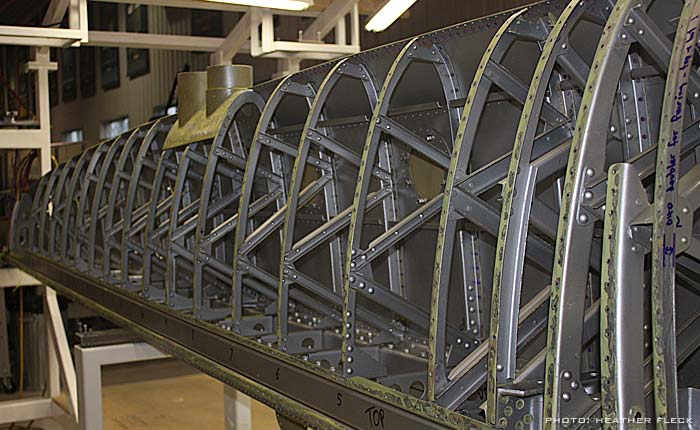Phase 2: Partnership with VWC in Comox (2008-2014)
Restoration proceeded slowly but surely, despite heroic volunteer efforts to raise funds and awareness. The pace was dictated by funds and by 2007, when the original plans had said the aircraft would be flying, only the fuselage and tail of Y2K were completed. Volunteer enthusiasm was being tested and it was becoming increasingly clear that considerable funds were going to be needed to finish this project: now anticipated to be over $2 million, a number twice the original estimate and several orders of magnitude beyond any CAFM fund raising campaign. The wings alone could cost upwards of $1.5 Million. Additionally, concerns were being raised about operating the finished aircraft, since personnel, facilities and resources to fly, hangar and display her were non-existent. It is worth noting that these concerns had been voiced as far back as 2002, but people had soldiered on, hoping for a breakthrough. In 2008, a formal analysis was conducted by a team of experts, convened by the Wing Commander. The team looked at all available options and reported that the project had little chance of success with the current fundraising plan and infrastructure and had the potential of becoming an expensive liability to NPF. It recommended that the project cease and the unfinished aircraft disposed of, unless a new owner could be found. The aircraft was formally offered to other Air Force museums, through CAPA, but there was no interest. One civilian agency offered to take it for scrap but their offer was rejected.
Vintage Wings of Canada (VWC), a not-for-profit Heritage Foundation, based just outside Ottawa, offered to take over the project in-situ, and provide the estimated money, expertise and facilities to restore it to flying status. This would create a partnership, with VWC restoring the Spitfire and CAFM hosting the Spitfire restoration display. The project was formally transferred to VWC after the following agreement, dated 12 March 2009, between the CDS and VWOC was reached:
- While it was being built in Comox it would be available as a CAFM display;
- The Test Flight program and a celebration event would be in Comox;
- Upon completion it would join the Heritage Aircraft Foundation, to be flown for the benefit of all Canadians on significant memorial occasions;
- It would be marked as the Comox Y2K Spitfire, civilian registration GYQQ; and
- VWC would attempt to restore the aircraft to flying condition within 30 months of the March 2009 Closing Date.
A formal “Provision of Service Agreement between 19 Wing Comox and VWOC was signed on 1 June 2009. This Agreement specified all the terms and conditions of VWOC using DND facilities. Of note, DND’s support of the Y2K Project continued: it was agreed that VWOC would not be charged any fees for use of 19 Wing facilities, provided that the conditions of the original sales agreement were met. Local management of the project was assigned to Colonel (ret) Terry Chester who VWOC designated as their Y2K Project Manager. Like so many others before him, he was an unpaid volunteer. Bonn Svensson, the chief AME, now worked for VWOC as the Y2K Project AME and had the resources and expertise of a significant company behind him. It certainly looked like “Y2K would fly again”.
VWOC shares a central ethos with the CAFM: things don’t make history; it is people that make history. Each aircraft in their collection, therefore, is named in honour of a Canadian that flew such an aircraft in combat, or on flight operations. Examples include the “Robert Hampton Gray” Corsair, the “William Lidstone McKnight” Hurricane and the “Stocky Edwards” Kittyhawk. As agreed, the Spitfire will always wear the markings of a 442 Squadron (RCAF) Spitfire coded Y2K. However, it will also be known as the “Arnold Roseland” Spitfire. Flight Lieutenant Arnold “Rosey” Roseland served on 442 Squadron and flew sixty five ops in Y2K. Sadly, he was killed in combat over St. Martin de Mailloc, France on July 13th, 1944. VWC will operate Spitfire TE294 as a flying testament to Roseland’s sacrifice, along with all the other brave Canadian Spitfire pilots who gave their lives in freedom’s name.
The transfer of Y2K from DND to VWC meant a change of airworthiness rulebooks: from DND military rules to Transport Canada civilian rules. The first step that VWOC took was to convert the workshop into a Transport Canada certified Approved Maintenance Operation (AMO). This involved some modification of the existing worksite, but the bulk of the work was in implementing Transport Canada processes, practices and record keeping. Unfortunately, at this time Mr. Svensson also began to suffer health problems and was forced to retire from the project. Terry Chester continued on as Y2K Project Manager and he needed to find new staff. A Mr. Kaven Tremblay was first hired to conduct an analysis and reconciliation of all the aircraft records. They were found by him to be remarkably incomplete and a major project was begun to organize and structure them in a format acceptable to Transport Canada. Next to be hired to manage the AMO was Mr. Ken Hazell, himself an AME with years of experience in aircraft structures. Most importantly for Ken, he had many contacts in the UK who had deep connections with the aircraft restoration business, and these were to prove extremely useful in later years. Dean Sept was also hired as the Y2K Project Principal AME. Dean also had an extensive background in aircraft structures and manufacture, having worked on the old MARs water bomber for years. The initial plan to create a stand-alone AMO for this project was found to be unnecessary. Instead, VWC determined that the Y2K Project could be run as a workshop (Sub-AMO) operating under the aegis of the existing VWC AMO, which was much better from a Transport Canada perspective.
With the new team in place in 2009, work began in earnest with the full weight, expertise and resources of VWV behind them. Unfortunately, it became increasingly clear that the structures and pieces that they had purchased were incapable of being certified as airworthy because the necessary records were incomplete or inaccurate. As a result, they quickly determined that the original September 2011 completion date was deemed impossible, since a complete verification process would now have to be completed. However the goal remained to complete the restoration as soon as was possible, but it would have to remain flexible as is the norm in such projects. The team in Comox would finish the fuselage, fuel systems, electrical systems, hydraulic and pneumatic systems and ready the aircraft for the delivery and installation of the wings. The wings are a complex, twisted structure designed for maximum maneuverability with significant internal strength and building them requires significant expertise and specialized jigs. It had been determined some years earlier that they could be best built by experts in this process who resided in the UK. As is true with almost all vintage aircraft restorations, there are only a handful of people world-wide that can fabricate these unique yet still airworthy parts. Mr. Ralph Hull in the United Kingdom was one of these acknowledged experts, in fact he had visited Comox, on a trip paid by the Y2K Project, to help set up the restoration area at the beginning of the project in 2000. Despite having a contract to hand-build a set of Spitfire wings ready for attachment to the aircraft, he was unable to fully complete them in time and on budget. In fact, there were several serious errors made in the wings’ construction. As a result, the partially completed wings had to be seized along with the jigs and tooling and shipped to Gatineau for finishing. As it turned out the constructed wings were largely unusable and VWC ended up building a new set of wings, based on spars put aside for another Spitfire restoration. With this turn of events, the situation and plans for finishing the aircraft in Comox changed once again.

